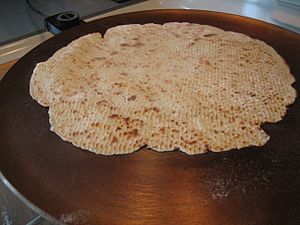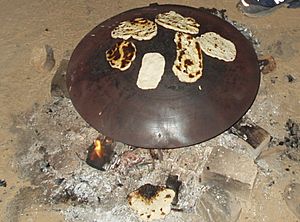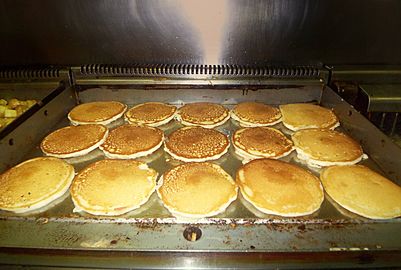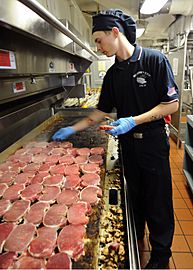Griddle facts for kids
Quick facts for kids Griddle |
|
|---|---|

Lefse cooking on an electric griddle
|
|
| Classification | Cooking equipment |
| Industry | Various |
| Application | Cooking |
| Fuel source | Traditional fuels, natural gas, propane, electric |
A griddle is a flat cooking surface. It's used to cook many kinds of food. You might know it as a "girdle" in the UK. Griddles can be a movable pan, a flat surface built into a stove, or a special cooking machine with its own heat.
Long ago, griddles were often stone slabs or metal discs. Today, most griddles are flat metal plates. They can be used at home or in restaurants. Griddles get hot from fire (like wood, coal, or gas) or from electricity. Big griddles used in restaurants often run on electricity, natural gas, or propane.
Griddles can be made from different materials. Some are made of cast iron. Others are non-stick. Griddles for homes might be made of cast iron, aluminium, or carbon steel. Most griddles used in restaurants are made from a type of steel called A36 steel. Some are stainless steel. Their surfaces can be polished steel or have a shiny chrome finish.
Contents
What's in a Name?
The word "griddle" has been used since the 1200s. It likely comes from an old French word, gridil. This word came from the Latin word craticula, which means 'small griddle'.
In Britain, people also call it a "girdle."
Griddles Through Time
Ancient Cooking Surfaces
Early griddles were often flat stones or brick slabs. People would heat these stones before putting food on them. Some early griddles were shallow dishes filled with sand. These were heated after the food was placed inside.
Later, griddles became removable iron plates. These plates would fit over the openings of wood-fired stoves. Even later, they became separate plates that covered burners on gas or electric stoves.
Middle Eastern Griddles

In the Middle East and parts of South Asia, a special griddle called a saj is used. A saj is a curved griddle. It's used to cook different kinds of flatbread.
Latin American Griddles
In Latin America, a traditional griddle is called a budare. It's made from stone or clay. People use it to cook flatbreads like tortillas, arepas, and casabe. Modern budares for restaurants are made of metal and are called comals.
Griddles in Britain
In Britain, the griddle (or "girdle") is used for making scones. It can be a thick, round iron plate. It often has a handle to hang it over a fire.
The traditional Scottish griddle is a flat wrought iron disc. It has a raised edge and a handle. This handle lets it hang over a fire from a chain. Scottish griddles are used for cooking scones, bannocks, pancakes, and oatcakes.
The traditional Welsh bakestone is similar. It's round and usually made of cast iron. It's about 1 cm thick. People use it to cook Welsh cakes, pikelets, and crepes.
Griddles in the United States
In some parts of Upstate New York, a griddle used to be the lid that covered a round opening on a wood or coal stove.
Restaurant Griddles
Popular Dishes
Griddles are very popular in restaurants. They are often used to cook breakfast foods like pancakes, French toast, eggs and bacon. They are also great for stir-fries and meats like hamburgers, steak, and chicken.
How They Work
Restaurant griddles can be very big, from 2 to 6 feet wide. Their cooking surfaces can be flat or have grooves. The heat for these griddles can be controlled by hand or with a special device called a thermostat. This helps keep the cooking temperature just right.
Gallery
See also
 In Spanish: Plancha de cocina para niños
In Spanish: Plancha de cocina para niños






